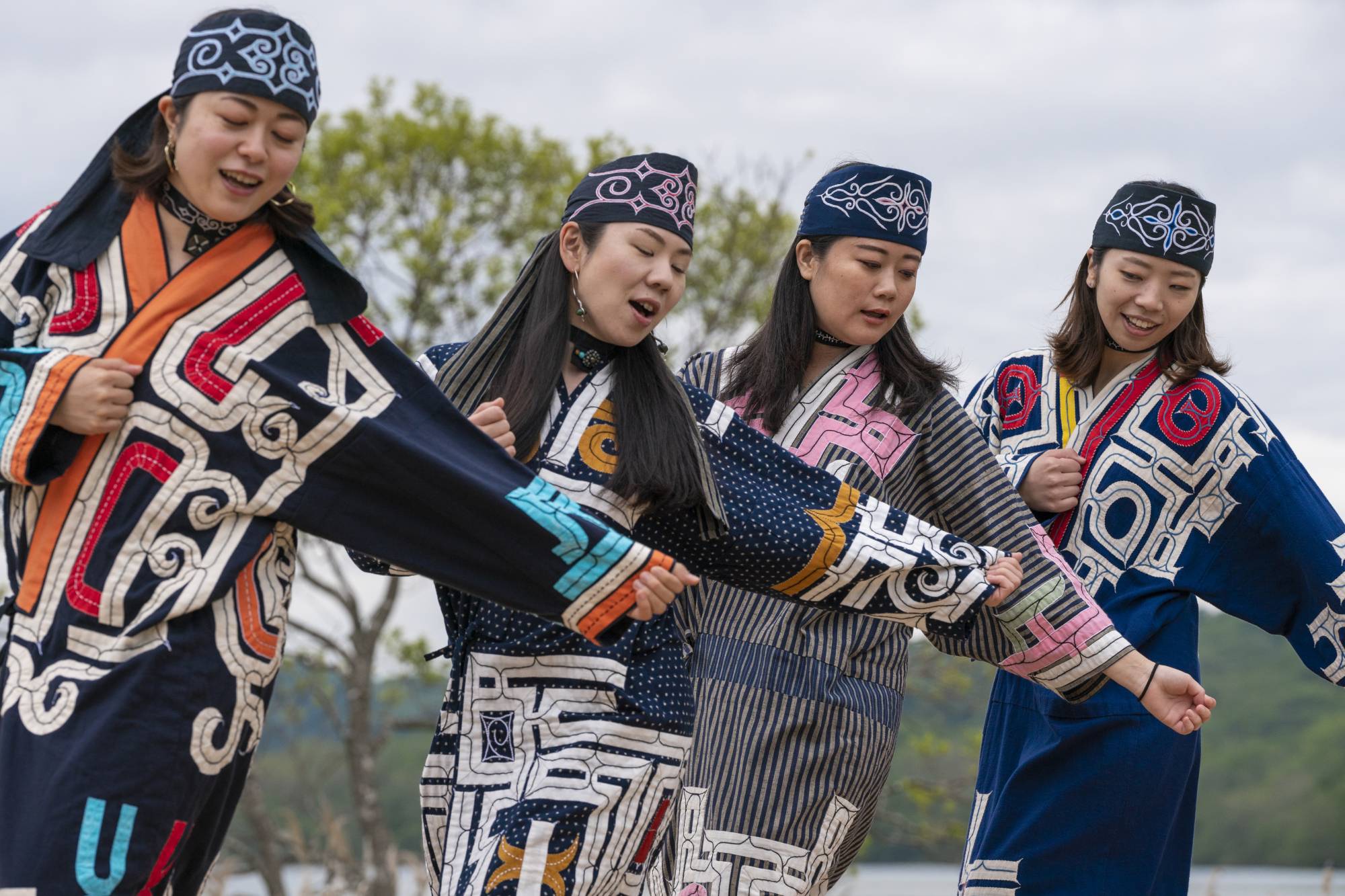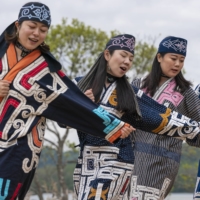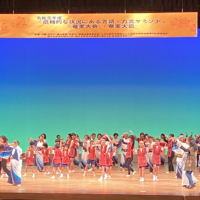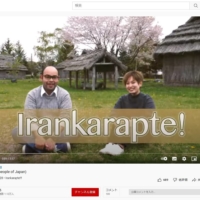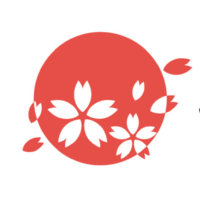Chances are you haven’t met an Ainu speaker in Japan. After all, Google’s Endangered Languages Project puts the number of native speakers at fewer than five. But the Ainu people once populated a wide swath of northern Japan, stretching from Tohoku to Hokkaido, the Chishima islands, and the southern part of Sakhalin Island.
A range of forces has pushed the Ainu language to the brink of extinction, galvanizing efforts by the government, community groups and citizens to preserve and revitalize it in a race against time. Today these include the Symbolic Space for Ethnic Harmony (Upopoy) that opened in Shiraoi, Hokkaido, in 2020 as well as projects designed to incorporate the language in daily life. For example, people can now hear announcements in Ainu on some bus routes in Hokkaido, and anyone with an internet connection can access a popular conversational Ainu channel on YouTube.
A broader long-running effort to protect the cultural identities of indigenous peoples is International Mother Language Day, which is observed every Feb. 21. Formally declared by UNESCO in 1999, International Mother Language Day sees a variety of worldwide events and workshops conducted to raise awareness of languages and promote multilingualism. It is also associated with the United Nations International Decade of Indigenous Languages, which kicks off this year.
According to the third edition of UNESCO’s Atlas of the World’s Languages in Danger, eight languages in Japan are endangered, including various Ryukyuan languages and Hachijo in addition to Ainu. The Ainu language is the only one designated as being critically endangered, where the “youngest speakers are grandparents and older, and they speak the language partially and infrequently.” On a five-level scale with five meaning extinct, this represents level four. Formerly there were distinct Hokkaido, Sakhalin and Kuril dialects of Ainu, but today UNESCO categorizes the Hokkaido dialect as the sole remaining dialect in existence.
It is difficult to pinpoint how many people can speak Ainu, or even how many Ainu people there are. According to a 2017 survey by the Hokkaido Prefectural Government, an estimated 13,118 people in Hokkaido identify as Ainu, although the actual number may never be known, given that past discrimination forced many to hide their Ainu heritage, even at times from their own children.
Ainu is categorized as a language isolate, meaning it doesn’t come from a protolanguage and cannot be linked to any language family. It is linguistically distinct from Japanese, and traditionally an oral language without an original writing system.
Nationwide promotion
The Ainu language has become critically endangered today due to various forces that have been in play for hundreds of years. In 1869, the Meiji government officially declared Hokkaido (then known as Ezo) part of Japan, after which wajin, (a historical term referring to the ethnic Japanese, or non-Ainu people) began moving into Hokkaido in far greater numbers. Shortly after, Ainu culture suffered another blow when many Ainu on Sakhalin and the Chishima islands were displaced to Hokkaido with the signing of a treaty between Japan and Russia in 1875.
The Meiji government also spearheaded a cultural enlightenment movement throughout Japan in which Ainu customs were regarded as “uncultivated” and many were restricted or prohibited. Schools for Ainu children were established to increase their attendance, but the Japanese language was given priority. While speaking Ainu was not specifically banned, using Japanese was expected at schools and government-run facilities. While these assimilation policies were intended to “civilize” the Ainu people, they caused Ainu to be spoken less, even within their families, leading to a precipitous drop in the number of Ainu speakers to the point where the language is now critically endangered.
The policies undertaken in the Meiji Era (1868 to 1912) to establish a modern nation-state resulted in decisive damage to Ainu cultural heritage and, coupled with discrimination from the overwhelming influx of wajin immigrants, marginalized the Ainu people and relegated them to poor living conditions. This situation started to change in the 1970s, when the Hokkaido Prefectural Government began taking steps to improve the living standards of Ainu people with support from the national government. These efforts have helped shrink the educational and economic disparities between Ainu residents and the wider communities in which they live. For example, in 1979 Ainu youth continued on to high school at a rate 21% lower than peers in their communities, and similarly enrolled in university at a 22% lower rate. But by 2017 these disparities had shrunk to 3.7% and 12.5%, respectively, according to a survey by the Hokkaido Prefectural Government.
The 1997 Act on the Promotion of Ainu Culture and Dissemination and Enlightenment of Knowledge about Ainu Tradition, etc. provided support for teaching, promoting and researching Ainu culture. The law’s definition of culture included the language, music, dance, handicrafts and other customs. The U.N. General Assembly adopted the Declaration on the Rights of Indigenous Peoples in 2007, prompting the Diet to pass a resolution in 2008 urging the government to recognize the Ainu people as an indigenous group. With this, the government expressed recognition that the Ainu are an indigenous people “with a unique language as well as religious and cultural distinctiveness.” The government subsequently established the Council for Ainu Policy Promotion, chaired by the chief Cabinet secretary, which laid the foundation for the 2019 passage of the Act Promoting Measures to Achieve a Society in which the Pride of Ainu People Is Respected.
This act seeks to increase understanding and respect for Ainu culture as part of broader understanding and respect for multiculturalism and coexistence with diverse ethnic groups. Government policies under the act will promote Ainu culture not only in Hokkaido, but also nationwide in recognition of the fact that Ainu are present in many regions of Japan today, not just Hokkaido.
Where the government had previously promoted the Japanese language over Ainu, it is now supporting efforts to preserve and promote the speaking of Ainu.
Recording Ainu language
One such effort involves recording the Ainu language. According to Masanari Suzuki, a senior specialist for the Japanese language at the Cultural Affairs Agency, since 2015 the agency has been spearheading a project to archive Ainu speech recordings. The project aims to create a repository of materials not only for academic research purposes, but also to build the linguistic infrastructure for people to learn Ainu and pass it down to future generations. As part of this project, the Cultural Affairs Agency is digitizing analog voice recordings and providing financial and technical assistance to Ainu communities and other groups that have materials in the language so they can create archival collections as well.
By March this year, the project expects to digitize a total of 4,403 hours of analog recordings. Some 670 hours of voice recordings are from the former Ainu Museum in Shiraoi, and 155 hours have been archived. The majority contain oral narratives and folklore. Much of the remaining recordings consist of interviews where privacy considerations require additional time in the archival process. The digitization process is scheduled to continue through 2026, with an eye to transcribing and translating the materials and releasing them as an archive.
In addition to digitizing and archiving materials, the project is creating a searchable linguistic corpus to make it easier for people to look up words and sample sentences in Ainu. The corpus can be used by Ainu speakers to build conversational skills as well as create new words in the language. It is in fact already being used this way — announcements at Upopoy, the new Ainu cultural facility, incorporate newly created Ainu words, Suzuki said.
Community participation
Upopoy, also known as the Symbolic Space for Ethnic Harmony, is designed to showcase and revitalize the Ainu culture. As a national center for learning about and promoting Ainu history and culture, Upopoy enables people of all nationalities and ages to learn about the Ainu’s worldview and respect for nature. It also acts as a symbol of a society based on mutual respect and coexistence, passing on and sharing various aspects of a culture that has developed over many years and is influenced by the surrounding nature. It opened in Shiraoi in July 2020 on the shore of Lake Poroto, which is about an hour from Sapporo and 40 minutes from New Chitose Airport.

Upopoy consists of the National Ainu Museum, the National Ainu Park and a Memorial Site for memorial services. Upopoy means “singing in a large group” in the Ainu language. Permanent museum exhibits focus on both the traditions and diversity of modern culture, spanning the themes of language, universe, lives, history, work and exchange from an Ainu perspective. The outdoor park features a re-creation of a kotan (traditional village), as well as a stage for traditional dance performances and areas for hands-on crafts, cooking and other activities.
Ainu people participated in the preparation of the exhibits and workshops at Upopoy, and their participation is also a focus of other recent government-sponsored projects.
Held since 2015, the Languages and Dialects in Danger Convention is sponsored by the Cultural Affairs Agency. Free and open to the public, the convention takes up topics related to the eight languages in Japan designated as endangered by UNESCO, as well as dialects in regions affected by the Great East Japan Earthquake. Participants share their multilingual experiences and how they have promoted both their language and language acquisition in their communities. While early conventions were mostly attended by older speakers, more recently the convention has attracted a larger number of younger participants, including school teachers interested in language acquisition.
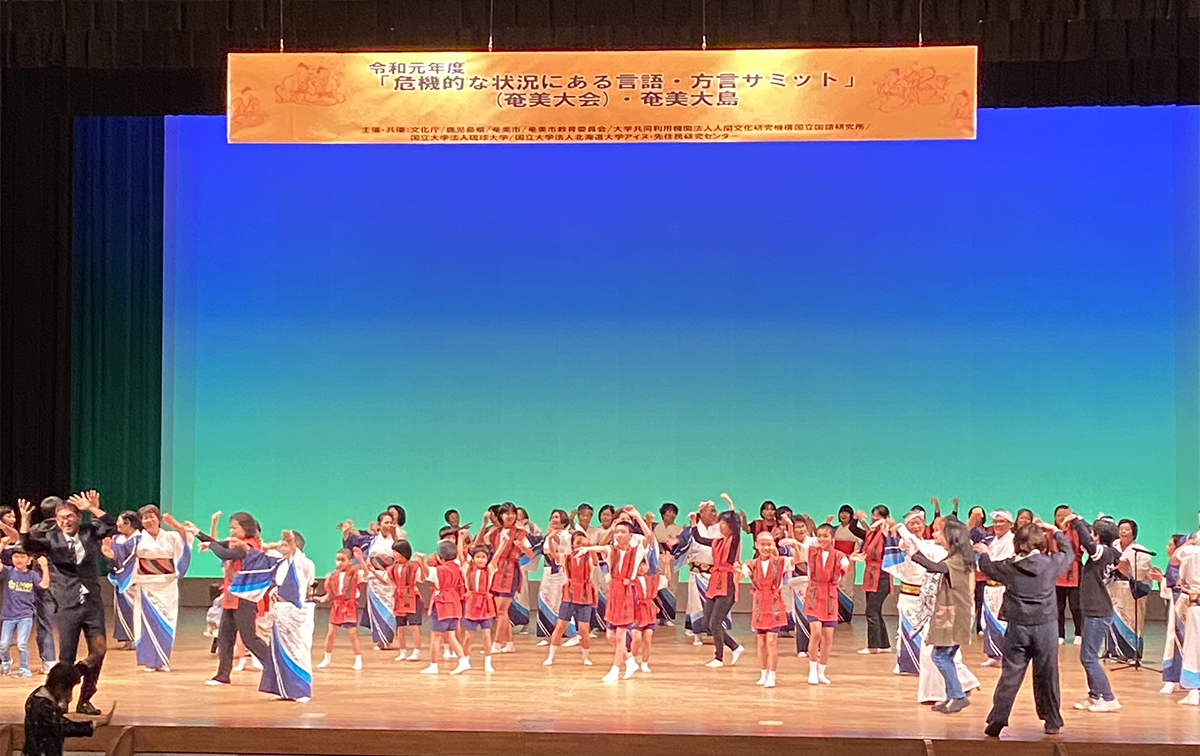
Learning chances expand
Established in 1997, the Foundation for Ainu Culture has been offering Ainu classes for years, including advanced classes, classes for parents and children and classes for training teachers. It has also been working to create Ainu-language teaching materials. On the radio, conversation lessons have been available since 1987. Accompanying textbooks are available for beginner courses and podcasts of the broadcasts can be downloaded from the internet.
In addition to lessons, community-based language acquisition focuses on creating more opportunities to hear the language in daily life. One innovative initiative launched by Donan Bus Co. is broadcasting announcements in Ainu on three bus lines in the town of Biratori, which includes Nibutani, Hokkaido, where more than 80% of residents have Ainu roots. Many passengers have reacted favorably to the announcements and have commented that it seems natural to hear the Ainu language.
Considering that around 80% of place names in Hokkaido come from Ainu, Hokkaido bus announcements may seem an especially natural fit for the language. Sapporo, for example, was called satporopet in Ainu. Sat means dry, poro means large, and pet means river. New words were also created for the bus announcements, including kampiop (seat pocket), uepekerkampi (leaflet) and tumamkauspe (poster).
In keeping with the goal of showcasing Ainu culture both in Japan and abroad, the Cultural Affairs Agency exhibited artwork last February on the theme of the sounds of Ainu culture at New Chitose Airport. The exhibit, produced by Naked, Inc., is an immersive sound and light experience incorporating narration in Ainu and music from Ainu instruments and songs.
In Sapporo, people traveling through Sapporo Station can visit the Minapa (“many people laugh”) Plaza, which features Ainu art exhibits as well as a big screen displaying the weather forecast in the Ainu language.
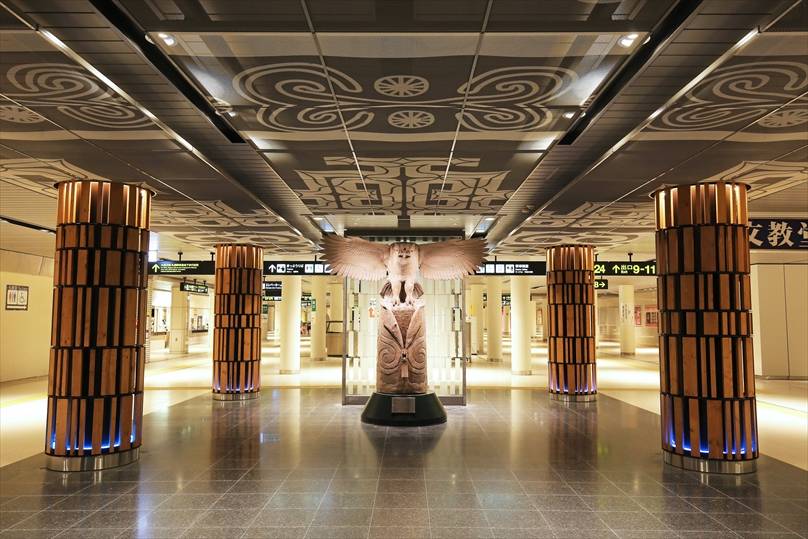
Youth take Ainu to YouTube
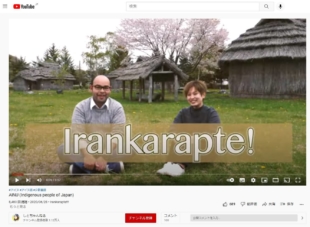
A modern-day complement to the traditional classes and radio lessons is YouTube video lessons. The Sito Channel (sito is a type of Ainu dumpling made of grain) offers dozens of lessons on conversational Ainu using topics of interest to young people. Starting with self-introductions, the lessons move on to talking about love interests, foods from traditional deer stew to shaved ice, songs, animals and everyday experiences like birthdays, hay fever and studying for tests. Comments on the YouTube channel include thanks from people studying Ainu in Japan and around the world.
The Sito Channel is run by Maya Sekine, a student at Keio University. Sekine grew up in the close-knit Ainu community of Nibutani. Her maternal grandparents and mother are Ainu artisans with Ainu heritage and her father, while not of Ainu descent, is an Ainu language instructor. Sekine says she was blessed for being able to grow up around Ainu foods and crafts, and to use Ainu words in daily conversation. She did not realize at the time how much the culture was a part of her childhood until she left Nibutani to attend junior high school elsewhere.
In an interview, she shared that she went through something of an identity crisis in her early teen years, even hiding her ethnicity at one point. But leaving her hometown ultimately gave her a new perspective on her culture and identity, which blossomed into pride in being Ainu by the time she entered high school in Sapporo.
Sekine has become something of a language and culture ambassador for the community through her efforts to broaden awareness of the language. In addition to her YouTube channel, she recorded bus announcements in Ainu when she was 18 and hosted Ainu radio lessons with her father Kenji in 2018.
Sekine says she senses a shift in how the Ainu culture is perceived today. Whereas older generations of Ainu people suffered discrimination, today’s Japanese are becoming more accepting of diversity, including differences in ethnicity, gender and sexual orientation. By increasing awareness of the Ainu language, she hopes to build acceptance for people from all kinds of identities and communities. While diversity is much discussed in society, it is not yet fully embraced. Sekine hopes that showcasing her Ainu background in accessible and positive ways will prompt people to become more open to diversity in general. She views her Ainu ethnicity as one part of her identity, something that is cool that she wants to share with others.
The Ainu people faced decades of hardships during which their language and cultural heritage were decisively damaged. The language has reached the point of being critically endangered, with only a few fluent speakers left. New initiatives launched by the government, including Upopoy and the Ainu language archive project, are seeking to promote the language and culture with greater grassroots participation by Ainu people for the benefit of their communities. There are now more opportunities than ever to see and hear the Ainu language in daily life, as well as a new generation of youth taking pride in their cultural heritage and interested in keeping the language alive. These efforts, coming from both the government and Ainu communities, offer the best hope yet for the survival of this critically endangered language.
This page is sponsored by the government of Japan.




